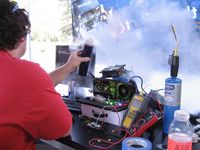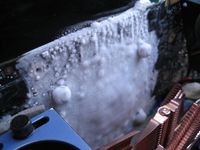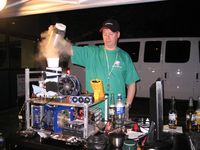Overclocking Goes Int'l.: Overdrive In The USA
What is Overclocking?
Most of our readers are very familiar with the term overclocking. The word defines itself, really. Integrated circuits are clocked above the sanctioned specifications in an effort to generate more performance. Many PC components can be overclocked. First and foremost, there is the processor. But you can also tweak the graphics card, the motherboard chipset, and system memory. Typically, clock speeds of some of these components are related, meaning that you may not be able to overclock one component without overclocking the other.
How to Start
The first stop for overclockers, after having purchased components that are suitable for overclocking, is the motherboard BIOS. For more information, please look into our Overclocking Guide, Part 1: Risk, Choices And Benefits. We’ll caution you right now—if you’ve never overclocked before, do lots of research before taking the plunge. This is a piece of advice we heard over and over from our guests. There are a plethora of online resources: sites like ocforums.com and XtremeSystems are two of the most revered. Of course, you can’t forget our own Overclocking Forums, either.
Where to Go?
It isn’t difficult to reach the overclocking limits of many mainstream components, which means that the overclocked component will become unstable, leaving you with a flaky hardware configuration. Early on in the game, you probably haven’t done any damage to your hardware and in 99% of all cases you can reset your system, go back to the BIOS and restore the original settings.
The taste of free performance can be addicting though, and if you want to milk even more speed from your hardware then you have to start accepting a bit more risk. Here’s where it helps to have a more intimate knowledge of your hardware (and hopefully, this is an area where our analysis can help improve your odds). If you’re familiar with integrated circuits, you know that they all need a certain voltage to operate and they show a certain power loss, which increases with clock speed and voltage. Increasing the operating voltage almost always gives you better clock speed margins, meaning that components may run at faster clock speeds reliably when increasing the voltage.
The downside is elevated heat dissipation, which will invariably stop you in your tracks once you start serious overclocking attempts. At this point you will want more efficient cooling solutions for your components.
Get Tom's Hardware's best news and in-depth reviews, straight to your inbox.
Why a Contest?
Here’s where we answer that question of “why overclock to an extreme beyond daily use?” Let’s say you enjoy playing basketball or tennis or soccer. But you’d be no match against a Kobe Bryant or a Roger Federer or a Cristisno Ronaldo. Those guys play at the most competitive degree possible, taking their respective sports to the next level. Well, if you want to take overclocking to the next level, it involves more than $50 copper heatsinks, ball-bearing fans, and five years of reliability testing. To really show off the talent of the experienced overclocker, you have to get much more extreme in technique and equipment.
Enter the realm of soldering irons, volt-modding, cold bugging, liquid nitrogen, and components that only last a day before bowing under the extraneous conditions of high voltage and extreme cold. When you’re overclocking at the bleeding edge, you design your own custom pots to maximize heat transfer according to the processor you’re tuning. You show up to competitions with a bevy of multimeters and thermocouples. You handle liquid nitrogen with bare hands and flip-flops—not because you don’t know how dangerous this stuff can be, but because you’re prepared for a full 18 hours of pouring, so comfort is key.
Yeah, it’s hard to appreciate the prep work and extreme duress that goes into elite overclocking by looking at a couple albums full of pictures, but spend two days around these guys and their lust for faster benchmark speeds becomes contagious and you can suddenly see why they spend their own money buying hardware doomed to a life of flogging under custom cooling gear.
Thus, an overclocking contest makes good sense. This stuff has become an art and a science of its own. It’s amazing to watch a hardware overclocker take the Vcore on a P45 board and E8600 to 1.9V (stock is up to 1.3625) and then complain that he doesn’t have enough voltage headroom and would really like to have 2.1V and 2.2V settings available. Other overclockers custom-build their cooling devices to achieve a better cooling effect. There are dozens of tools and multiple manufacturer utilities to assist overclocking, and utilizing very unconventional cooling techniques such as compressor cooling, dry ice, and liquid nitrogen help to further push the limits away.
We decided to gather some of these hardcore overclockers, because they all collected tremendous experience when it comes to operating mainstream hardware. We will provide an insight as to how they work, and we’ll provide them the chance to battle each other using Intel’s latest Core i7 processors at our finals in December.
Of course, the event wouldn’t be complete without a prize. So, in addition to giving our overclockers the hardware the so mercilessly beat down, they’re also in the running for a $5,000 grand prize, which will go to the winner of our finals next month.
Current page: What is Overclocking?
Prev Page An Introduction To Our Championship Next Page The Championship


